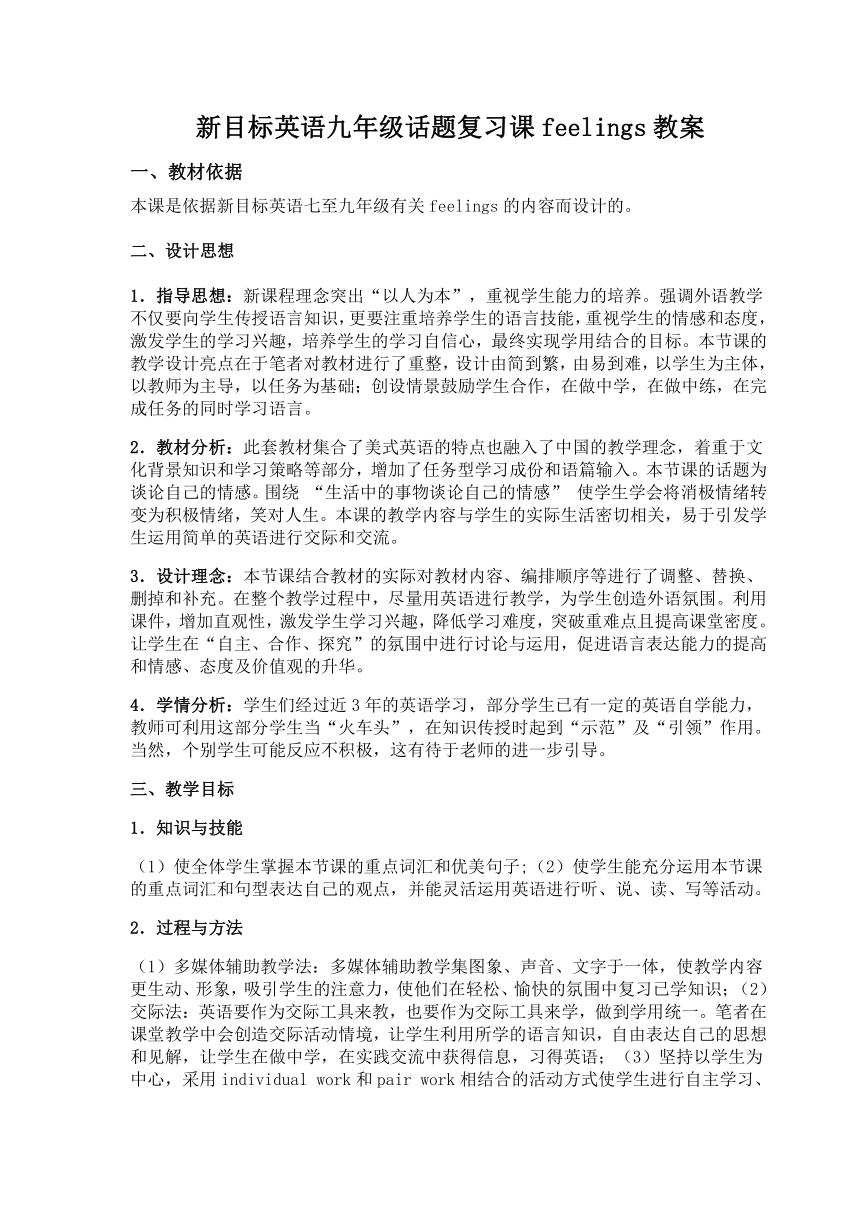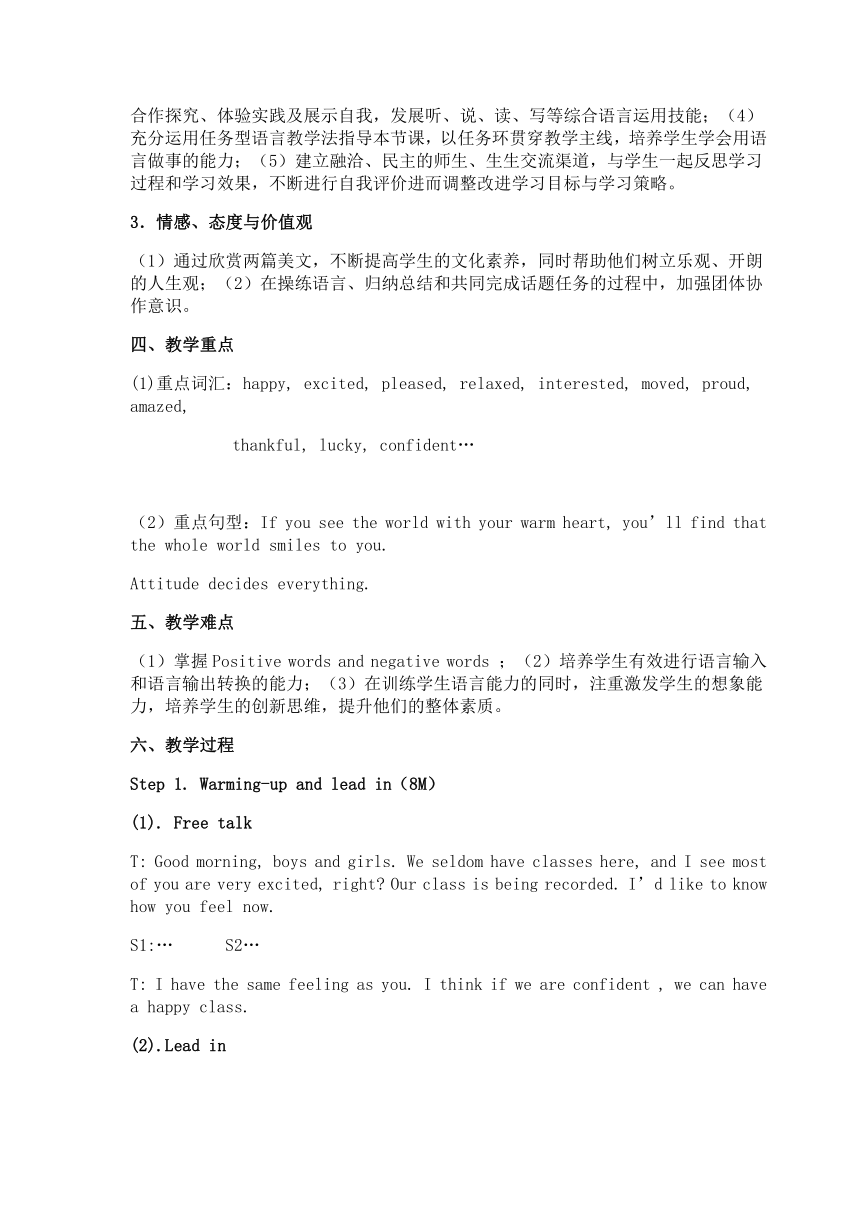人教版九年级全册 Unit11 Sad movies make me cry话题复习教案
文档属性
| 名称 | 人教版九年级全册 Unit11 Sad movies make me cry话题复习教案 |  | |
| 格式 | doc | ||
| 文件大小 | 39.5KB | ||
| 资源类型 | 教案 | ||
| 版本资源 | 人教新目标(Go for it)版 | ||
| 科目 | 英语 | ||
| 更新时间 | 2023-01-09 14:59:11 | ||
图片预览


文档简介
新目标英语九年级话题复习课feelings教案
一、教材依据
本课是依据新目标英语七至九年级有关feelings的内容而设计的。
二、设计思想
1.指导思想:新课程理念突出“以人为本”,重视学生能力的培养。强调外语教学不仅要向学生传授语言知识,更要注重培养学生的语言技能,重视学生的情感和态度,激发学生的学习兴趣,培养学生的学习自信心,最终实现学用结合的目标。本节课的教学设计亮点在于笔者对教材进行了重整,设计由简到繁,由易到难,以学生为主体,以教师为主导,以任务为基础;创设情景鼓励学生合作,在做中学,在做中练,在完成任务的同时学习语言。
2.教材分析:此套教材集合了美式英语的特点也融入了中国的教学理念,着重于文化背景知识和学习策略等部分,增加了任务型学习成份和语篇输入。本节课的话题为谈论自己的情感。围绕 “生活中的事物谈论自己的情感” 使学生学会将消极情绪转变为积极情绪,笑对人生。本课的教学内容与学生的实际生活密切相关,易于引发学生运用简单的英语进行交际和交流。
3.设计理念:本节课结合教材的实际对教材内容、编排顺序等进行了调整、替换、删掉和补充。在整个教学过程中,尽量用英语进行教学,为学生创造外语氛围。利用课件,增加直观性,激发学生学习兴趣,降低学习难度,突破重难点且提高课堂密度。让学生在“自主、合作、探究”的氛围中进行讨论与运用,促进语言表达能力的提高和情感、态度及价值观的升华。
4.学情分析:学生们经过近3年的英语学习,部分学生已有一定的英语自学能力,教师可利用这部分学生当“火车头”,在知识传授时起到“示范”及“引领”作用。当然,个别学生可能反应不积极,这有待于老师的进一步引导。
三、教学目标
1.知识与技能
(1)使全体学生掌握本节课的重点词汇和优美句子;(2)使学生能充分运用本节课的重点词汇和句型表达自己的观点,并能灵活运用英语进行听、说、读、写等活动。
2.过程与方法
(1)多媒体辅助教学法:多媒体辅助教学集图象、声音、文字于一体,使教学内容更生动、形象,吸引学生的注意力,使他们在轻松、愉快的氛围中复习已学知识;(2)交际法:英语要作为交际工具来教,也要作为交际工具来学,做到学用统一。笔者在课堂教学中会创造交际活动情境,让学生利用所学的语言知识,自由表达自己的思想和见解,让学生在做中学,在实践交流中获得信息,习得英语;(3)坚持以学生为中心,采用individual work和pair work相结合的活动方式使学生进行自主学习、合作探究、体验实践及展示自我,发展听、说、读、写等综合语言运用技能;(4)充分运用任务型语言教学法指导本节课,以任务环贯穿教学主线,培养学生学会用语言做事的能力;(5)建立融洽、民主的师生、生生交流渠道,与学生一起反思学习过程和学习效果,不断进行自我评价进而调整改进学习目标与学习策略。
3.情感、态度与价值观
(1)通过欣赏两篇美文,不断提高学生的文化素养,同时帮助他们树立乐观、开朗的人生观;(2)在操练语言、归纳总结和共同完成话题任务的过程中,加强团体协作意识。
四、教学重点
(1)重点词汇:happy, excited, pleased, relaxed, interested, moved, proud, amazed,
thankful, lucky, confident…
(2)重点句型:If you see the world with your warm heart, you’ll find that the whole world smiles to you.
Attitude decides everything.
五、教学难点
(1)掌握Positive words and negative words ;(2)培养学生有效进行语言输入和语言输出转换的能力;(3)在训练学生语言能力的同时,注重激发学生的想象能力,培养学生的创新思维,提升他们的整体素质。
六、教学过程
Step 1. Warming-up and lead in(8M)
(1). Free talk
T: Good morning, boys and girls. We seldom have classes here, and I see most of you are very excited, right Our class is being recorded. I’d like to know how you feel now.
S1:… S2…
T: I have the same feeling as you. I think if we are confident , we can have a happy class.
(2).Lead in
T: You know confident, happy are the words that can show our positive feelings. Can you tell me some words like this
S1:… S2:…
T: Ok, people have positive feelings and negative feelings Can you tell me some words like nervous
S1:… S2:…
Step2. Learn to use the words.
T: Here are the words we have learned. Let’s read them.
T: These words can show our feelings. Let’s see if you know how to use them.
Choose some students to finish the sentences.
T: Let’s read them.
Step 3. Cloze
T: Do you know him (Point to the picture of Liu Wei) His story is very moving. Let’s watch a video about him.
T: After watching the video, I have to say he makes me surprised. He can play the piano so well with his feet. How do you feel about him
S1:… S2:…
T: The passage will tell us others’feelings about him. Read the passage and fill in the blanks. Before we do it, let’s predict what kind of words we should fill in.
T: Now take out this piece of paper and fill in the blanks.
Choose one to tell me the answers by reading it.
T: Excellent! Let’s read it together.
Step4. Reading.
T: His story tells us how to face difficulties bravely. Here is another article. It tells us how to be happy. Look through it and find out the main ideas of the four paragraphs.
Tell them to pay attention to the first sentence of each paragraph.
Check the answers by telling the key sentences.
T: Now you know the main ideas of each paragraph. I’m sure you know the general idea of this passage. I have some more difficult problems for you. Read it again and finish them. You’d better find out the key sentences, too.
Check the answers by telling the key sentences.
Tell them while we are reading, we can use the reading ways on the screen.
T: This is a good passage. There are some beautiful sentences in it. Do you remember them Look them up in the passage.
Check the answers and read together.
Step5. Writing.
T: From Liu Wei’s story and the article, we know that we should learn to smile in our daily life. Ok. Can you use what we have learned to write this composition Let’s see how to write it. Usually we divide an article into three parts: beginning, body and ending. Which point can be the beginning Which point can be the body Which point can be the ending Who can tell me how to write the beginning, the key sentences of the body, the ending
Give them some minutes to think and choose some to tell how to write.
T: Great! This is my outline. Please make your outline and write your composition.
After they have finished writing, choose 2 students to read. Check the points and requirements, and comment on the 2 compositions. Then tell them if they can use some linking words like the blue words, they can get better scores.
T: In our daily life, we may meet many difficulties. We’d better face it with smiles.
一、教材依据
本课是依据新目标英语七至九年级有关feelings的内容而设计的。
二、设计思想
1.指导思想:新课程理念突出“以人为本”,重视学生能力的培养。强调外语教学不仅要向学生传授语言知识,更要注重培养学生的语言技能,重视学生的情感和态度,激发学生的学习兴趣,培养学生的学习自信心,最终实现学用结合的目标。本节课的教学设计亮点在于笔者对教材进行了重整,设计由简到繁,由易到难,以学生为主体,以教师为主导,以任务为基础;创设情景鼓励学生合作,在做中学,在做中练,在完成任务的同时学习语言。
2.教材分析:此套教材集合了美式英语的特点也融入了中国的教学理念,着重于文化背景知识和学习策略等部分,增加了任务型学习成份和语篇输入。本节课的话题为谈论自己的情感。围绕 “生活中的事物谈论自己的情感” 使学生学会将消极情绪转变为积极情绪,笑对人生。本课的教学内容与学生的实际生活密切相关,易于引发学生运用简单的英语进行交际和交流。
3.设计理念:本节课结合教材的实际对教材内容、编排顺序等进行了调整、替换、删掉和补充。在整个教学过程中,尽量用英语进行教学,为学生创造外语氛围。利用课件,增加直观性,激发学生学习兴趣,降低学习难度,突破重难点且提高课堂密度。让学生在“自主、合作、探究”的氛围中进行讨论与运用,促进语言表达能力的提高和情感、态度及价值观的升华。
4.学情分析:学生们经过近3年的英语学习,部分学生已有一定的英语自学能力,教师可利用这部分学生当“火车头”,在知识传授时起到“示范”及“引领”作用。当然,个别学生可能反应不积极,这有待于老师的进一步引导。
三、教学目标
1.知识与技能
(1)使全体学生掌握本节课的重点词汇和优美句子;(2)使学生能充分运用本节课的重点词汇和句型表达自己的观点,并能灵活运用英语进行听、说、读、写等活动。
2.过程与方法
(1)多媒体辅助教学法:多媒体辅助教学集图象、声音、文字于一体,使教学内容更生动、形象,吸引学生的注意力,使他们在轻松、愉快的氛围中复习已学知识;(2)交际法:英语要作为交际工具来教,也要作为交际工具来学,做到学用统一。笔者在课堂教学中会创造交际活动情境,让学生利用所学的语言知识,自由表达自己的思想和见解,让学生在做中学,在实践交流中获得信息,习得英语;(3)坚持以学生为中心,采用individual work和pair work相结合的活动方式使学生进行自主学习、合作探究、体验实践及展示自我,发展听、说、读、写等综合语言运用技能;(4)充分运用任务型语言教学法指导本节课,以任务环贯穿教学主线,培养学生学会用语言做事的能力;(5)建立融洽、民主的师生、生生交流渠道,与学生一起反思学习过程和学习效果,不断进行自我评价进而调整改进学习目标与学习策略。
3.情感、态度与价值观
(1)通过欣赏两篇美文,不断提高学生的文化素养,同时帮助他们树立乐观、开朗的人生观;(2)在操练语言、归纳总结和共同完成话题任务的过程中,加强团体协作意识。
四、教学重点
(1)重点词汇:happy, excited, pleased, relaxed, interested, moved, proud, amazed,
thankful, lucky, confident…
(2)重点句型:If you see the world with your warm heart, you’ll find that the whole world smiles to you.
Attitude decides everything.
五、教学难点
(1)掌握Positive words and negative words ;(2)培养学生有效进行语言输入和语言输出转换的能力;(3)在训练学生语言能力的同时,注重激发学生的想象能力,培养学生的创新思维,提升他们的整体素质。
六、教学过程
Step 1. Warming-up and lead in(8M)
(1). Free talk
T: Good morning, boys and girls. We seldom have classes here, and I see most of you are very excited, right Our class is being recorded. I’d like to know how you feel now.
S1:… S2…
T: I have the same feeling as you. I think if we are confident , we can have a happy class.
(2).Lead in
T: You know confident, happy are the words that can show our positive feelings. Can you tell me some words like this
S1:… S2:…
T: Ok, people have positive feelings and negative feelings Can you tell me some words like nervous
S1:… S2:…
Step2. Learn to use the words.
T: Here are the words we have learned. Let’s read them.
T: These words can show our feelings. Let’s see if you know how to use them.
Choose some students to finish the sentences.
T: Let’s read them.
Step 3. Cloze
T: Do you know him (Point to the picture of Liu Wei) His story is very moving. Let’s watch a video about him.
T: After watching the video, I have to say he makes me surprised. He can play the piano so well with his feet. How do you feel about him
S1:… S2:…
T: The passage will tell us others’feelings about him. Read the passage and fill in the blanks. Before we do it, let’s predict what kind of words we should fill in.
T: Now take out this piece of paper and fill in the blanks.
Choose one to tell me the answers by reading it.
T: Excellent! Let’s read it together.
Step4. Reading.
T: His story tells us how to face difficulties bravely. Here is another article. It tells us how to be happy. Look through it and find out the main ideas of the four paragraphs.
Tell them to pay attention to the first sentence of each paragraph.
Check the answers by telling the key sentences.
T: Now you know the main ideas of each paragraph. I’m sure you know the general idea of this passage. I have some more difficult problems for you. Read it again and finish them. You’d better find out the key sentences, too.
Check the answers by telling the key sentences.
Tell them while we are reading, we can use the reading ways on the screen.
T: This is a good passage. There are some beautiful sentences in it. Do you remember them Look them up in the passage.
Check the answers and read together.
Step5. Writing.
T: From Liu Wei’s story and the article, we know that we should learn to smile in our daily life. Ok. Can you use what we have learned to write this composition Let’s see how to write it. Usually we divide an article into three parts: beginning, body and ending. Which point can be the beginning Which point can be the body Which point can be the ending Who can tell me how to write the beginning, the key sentences of the body, the ending
Give them some minutes to think and choose some to tell how to write.
T: Great! This is my outline. Please make your outline and write your composition.
After they have finished writing, choose 2 students to read. Check the points and requirements, and comment on the 2 compositions. Then tell them if they can use some linking words like the blue words, they can get better scores.
T: In our daily life, we may meet many difficulties. We’d better face it with smiles.
同课章节目录
- Unit 1 How can we become good learners.
- Section A
- Section B
- Unit 2 I think that mooncakes are delicious!
- Section A
- Section B
- Unit 3 Could you please tell me where the restroom
- Section A
- Section B
- Unit 4 I used to be afraid of the dark.
- Section A
- Section B
- Unit 5 What are the shirts made of?
- Section A
- Section B
- Review of Units 1-5
- Unit 6 When was it invented?
- Section A
- Section B
- Unit 7 Teenagers should be allowed to choose their
- Section A
- Section B
- Unit 8 It must belong to Carla.
- Section A
- Section B
- Unit 9 I like music that I can dance to.
- Section A
- Section B
- Unit 10 You're supposed to shake hands.
- Section A
- Section B
- Review of Units 6-10
- Unit 11 Sad movies make me cry.
- Section A
- Section B
- Unit 12 Life is full of the unexpected
- Section A
- Section B
- Unit 13 We're trying to save the earth!
- Section A
- Section B
- Unit 14 I remember meeting all of you in Grade 7.
- Section A
- Section B
- Review of Units 11-14
